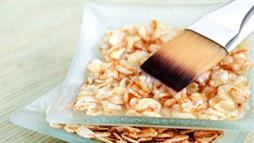Oatmean, Minus the Glyphosate, Is REALLY Good For You
Is Oatmeal Really Good for Your Skin?
- May 12, 2018 • 11,831 views

Story at-a-glance
- Oatmeal has been used for millennia for soothing itchy, irritated skin and is a popular ingredient in many shampoos and lotions
- Researchers found that cancer patients undergoing chemotherapy treatments often have painful burns and rashes that colloidal oatmeal treats successfully
- Beta-glucans, saponins and polysaccharides in oatmeal give it amazing cleansing and emollient capabilities, also giving it anti-inflammatory, antioxidant and anticarcinogenic potential
By Dr. Mercola
You may have noticed oatmeal listed as a principal ingredient in several skin cleansers and lotions, ostensibly because clinical studies expounding the merits of oatmeal would make it a beneficial, as well as natural, component.
After all, oatmeal, aka Avena sativa, grown in Russia, Europe, Asia, North and South America and Down Under, has been used for thousands of years as a topical lotion for aggravated skin from dryness or even insect bites, a study in the Journal of Drugs in Dermatology,1 sponsored by Johnson & Johnson, states.
Some may assume oatmeal used for this purpose is just another fad. After all, particularly in marketing terms, oatmeal is arguably as close to wholesome as mom and apple pie. But could oatmeal used therapeutically actually have merit?
The above study identified oatmeal as “a soothing agent to relieve itch and irritation,” made into a “colloidal” or homogenous mixture by grinding oatmeal and boiling it down to form skin cleansers, shaving gels and moisturizing creams. But here’s the kicker. The recipe for this grain, usually thought of as a breakfast food, is standardized by the United States Pharmacopeia2 and its use as a skin protectant is regulated by the U.S. Food and Drug Administration (FDA) for medicinal purposes. 3
What Oatmeal Can Do for Skin and Why It’s So Important
Nearly everyone would say dry skin can be annoying, uncomfortable and even unsightly, but cancer patients undergoing chemotherapy treatments have a particular need. Nutrition Facts notes:
“There’s a class of chemo drugs, like Cetuximab, that can cause an awful rash. Various treatments have been tried and failed. There was no clear preventive or curative treatment for this eruption …The researchers had heard about a study where human skin fragments from plastic surgery were subjected to an inflammatory chemical, and adding an oatmeal extract appeared to help.”4
When researchers learned from a Georgetown University study5 that an oatmeal extract had been used successfully to soothe these patients’ skin, their subsequent report caused a sensation in the medical world. Of the 10 patients exhibiting chemotherapy drug-induced rashes who agreed to try the oatmeal extract lotion,6 six had a “complete response” and four had a “partial response,” which the scientists deemed to be a 100 percent rating for the oatmeal extract.
Here’s why: According to Journal of Drugs in Dermatology study, saponins in oatmeal give it the ability to cleanse, moisturize and soothe, basically providing a “buffer” to keep skin hydrated and protected.
Further, phenols contribute “strong ultraviolet absorbers” and the starches and beta-glucans are recognized as humectant, or able to hold water, which furthers the product’s ability to act as an emollient. Those beta-glucans are something to pay attention to, as the next section explains.
The Incredible Function of Beta-Glucans in Oatmeal
A Lithuanian study7 called beta-glucans naturally occurring polysaccharides; glucose polymers that are part of the cell wall of certain pathogenic bacteria and fungi. Beta-glucans, the study reported:
- Increase host immune defense
- Exhibit anticarcinogenic activity
- Confer antioxidant and anti-inflammatory capability
- Fight cancerous tumor formation and metastasis
The Georgetown University study noted that current treatment modalities for epidermal growth factor (EGFR)-positive cancers unfortunately cause the aforementioned side effects, for which there were no effective treatments. It also showed colloidal oatmeal to have “multiple anti-inflammatory properties with known effects on arachidonic acid,” which is important for skin health.8
Doctors from all over the world were intrigued enough by the study to try oatmeal extract on their own patients and got the same incredible results. DermNet New Zealand9 lists other skin conditions that may benefit from colloidal oatmeal:
- Atopic and contact dermatitis (eczema)
- Chickenpox
- Insect bites
- Poison ivy
- Dry skin
Further, compounds in colloidal oatmeal exhibit ultraviolet light absorption to protect against sun damage and photoaging, as well as inhibiting prostaglandin production.
How to Make DIY Colloidal Oatmeal Cream, Lotion and Bath Treatments
Oatmeal absorbs water easily and helps keep your skin hydrated and soothed. You can make your own silky colloidal oatmeal bath at home to gain these benefits, and the process is quick, easy and inexpensive. Simply place a cup of organic dry oatmeal into a blender, coffee grinder or food processor and process until it becomes a fine powder.
Sprinkle about a cup of ground oatmeal into warm rather than hot water, the latter of which tends to further dry your skin. Soak for about 15 minutes, but not too long. Afterward, pat your skin dry to retain some of the oatmeal benefits. Make your own do-it-yourself oatmeal hand cream, from The Thrifty Couple,10 with a few more beneficial ingredients, such as coconut oil, olive oil and essential oils:
Colloidal Oatmeal Hand Cream
Ingredients:
- ¼ cup finely ground oatmeal
- ¾ cup coconut oil
- A few drops of rosemary essential oil
- 1 Tbsp. olive oil
Procedure:
- Melt the coconut oil slowly over low heat until it turns to a liquid.
- Add a few drops of rosemary oil and mix thoroughly. Mix in the oatmeal until completely blended, then add the olive oil and blend.
- Pour your moisturizer into baby food jars or other small containers to harden, and store at room temperature, or if it’s more than 76 degrees F, refrigerate.
A second recipe from Natural and Healthy Living11 explains how to make a homeade eczema cream using a few more ingredients, including shea butter, vitamin E oil and lavender essential oil, with the added step of cooling and partially solidifying the coconut oil in the freezer so that the other ingredients, especially the oats, don’t sink to the bottom.
What Happens When You Eat Oatmeal? Is It Just as Beneficial?
Two cancer cell lines found to be resistant to Cetuximab chemotherapy in vitro (in a test tube or culture dish)12 were responsive to one of the compounds in the oatmeal extract: avenanthramides, a unique phytonutrient contained in oats.
One study noted that avenanthramides exert strong antioxidant activity in vivo, or within living organisms like humans. Besides being antiproliferative against cancer, the study suggested they may also provide protection against coronary heart disease and colon cancer.13
That being said, I typically recommend limiting or eliminating your intake of grains, including oats, as even whole grains can raise your insulin and leptin levels, a driving factor in most chronic diseases.
Further, grains are increasingly subject to glyphosate residue because so many foods are tainted by Monsanto’s penchant for selling carcinogenic substances like this one. The Alliance for Natural Health USA submitted a paper listing breakfast foods with potentially unsafe glyphosate levels, and oatmeal is on it — three times.14 In short, oatmeal has benefits when applied topically, but there are far healthier foods to focus your meals around. As Nutrition Facts put it:
“Oatmeal — a simple topical agent producing such spectacular benefit where more complex therapies have failed. In an age when ever more expensive treatments are consistently being championed, it would be a great pity if this inexpensive, natural approach to relieving distressing symptoms were to be overlooked.”15















